Cylindrical cavity in a layer of solid explosives: dynamics of collaps on impact, critical conditions for explosion
- Authors: Dubovik A.V.1
-
Affiliations:
- Semenov Federal Research Center for Chemical Physics of the Russian Academy of Sciences
- Issue: Vol 44, No 4 (2025)
- Pages: 46-53
- Section: Combustion, explosion and shock waves
- URL: https://ta-journal.ru/0207-401X/article/view/682725
- DOI: https://doi.org/10.31857/S0207401X25040052
- ID: 682725
Cite item
Abstract
A numerical and analytical solution has been carried out for the hydrodynamic problem of the collapse of a cylindrical cavity in a freely spreading layer of solid explosive upon impact. Based on the results of calculations of the conditions for the initiation of HMX-type explosive charges, the critical impact parameters, geometric and physical-mechanical characteristics of the layer and the properties of the gas cavity were determined. The dual role of gas in the cavity was established, in some cases facilitating or preventing the process of explosion occurrence.
Keywords
Full Text
About the authors
A. V. Dubovik
Semenov Federal Research Center for Chemical Physics of the Russian Academy of Sciences
Author for correspondence.
Email: a-dubovik@mail.ru
Russian Federation, Moscow
References
- F.P. Bowden, A.F. Ioffe. Initiation and Growth of Explosion in Solids and Liquids (Cambridge University Press, 1952).
- N.A. Kholevo. Sensitivity of Explosives to Iimpact (Mashinostroenie, Moscow, 1974) [in Russian].
- K.K. Andreev, A.F. Belyaev. Theory of Explosives (Oborongiz, Moscow, 1960) [in Russian].
- G.T. Afanasyev, V.K Bobolev. Initiation of Solid Explosives by Impact (Nauka, Moscow, 1968) [in Russian].
- B.A. Khasainov, A.V. Attetkov, A.A. Borisov. Khimicheskaya Fizika 15(7), 103 (1996).
- E.I. Andriankin, V.K. Bobolev, A.V Dubovik. Applied Mechanics and Technical Physics, 6, 98 (1970).
- A.A. Ilyushin. Plasticity (OGIZ, Moscow, 1948) [in Russian].
- N.B.Vargaftik. Handbook on the Tthermophysical Properties of Gases and Liquids (Nauka, Moscow, 1972) [in Russian].
- L.M. Kachanov. Fundamentals of the Theory of Plasticity (Nauka, Moscow, 1969) [in Russian].
- G.I. Nazin, B.L. Korsunskiy, A.I. Karasev, A.V, Nabatova, N.G. Samoilenko. Russ. J. Phys. Chem. B 17(2), 406 (2023). https://doi.org/10.1134/S1990793123020124
- A.V. Dubovik. Russ. J. Phys. Chem. B 17(2), 369 (2023). https://doi.org/10.1134/S1990793123020057.
- V.N. Marshakov and V.G. Krupkin. Russ. J. Phys. Chem. B 17(2), 388 (2023). https://doi.org/10.1134/S1990793123020100
- A.V. Dubovik. Russ. J. Phys. Chem. B 16(2), 260 (2022). https://doi.org/10.1134/S1990793122020051
Supplementary files
















